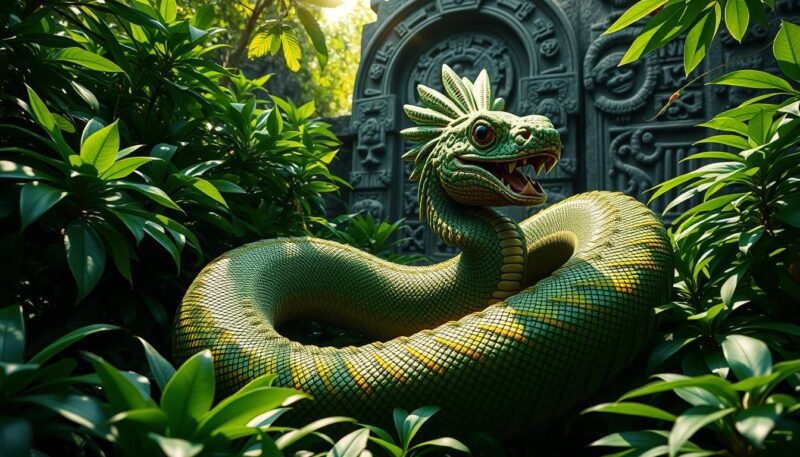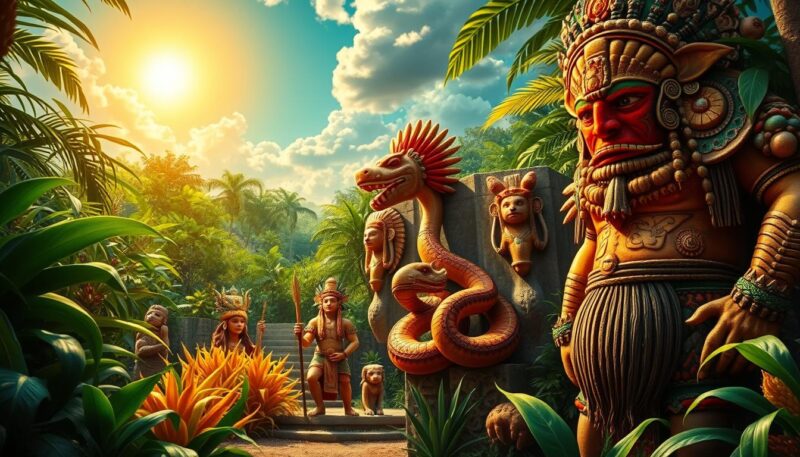The ancient Maya civilization, which flourished from A.D. 250 to 900 during its Classic period, is renowned for its intricate culture, impressive cities, and rich mythology. Central to this civilization were the Mayan gods, a vast pantheon that comprised over 250 sacred deities revered across regions such as the Yucatan, Guatemala, and Belize. These gods played a pivotal role in shaping societal norms, agricultural practices, and the people’s expectations regarding life and afterlife. Each deity was interwoven with daily life, influencing everything from the weather and harvests to birth and death.
The foundations of Mayan mythology can be traced back to specific events described in hieroglyphic records, which date back to around August 11, 3114 B.C. These texts indicate that deities “were set in order,” suggesting a divine organization that significantly impacted the community’s ethos. Additionally, the narrative of these gods echoes themes of creation, struggle, and survival, often linked to vital agricultural staples like maize—a cornerstone of Mayan diet and culture.
This article seeks to explore the pantheon of Mayan gods, their features, and the diverse ways in which they were worshiped. From the fearsome Kukulkan, the Feathered Serpent, to the nurturing Ix Chel, the Moon Goddess, each deity represents a facet of the complex Mayan worldview that continues to intrigue scholars and travelers alike. Join us as we delve into the rich tapestry of Mayan mythology, uncovering what gods did the Mayans worship and how these fascinating deities influenced the ancient civilization’s daily life.
Mayan Religion and the Pantheon of Deities
Mayan religion displays a complex relationship with the cosmos, intertwining beliefs about creation, life, and the afterlife through its extensive pantheon of deities. The gods of the Maya were categorized based on their functional roles, reflecting the intricate makeup of Mayan cosmology. Their presence informed every aspect of daily life, with rituals and ceremonies serving as key expressions of devotion and respect.
Understanding Mayan Cosmology
Mayan cosmology consists of three realms: kab (Earth), kan (sky), and xibalba (underworld). Various gods were responsible for these realms, enriching the Mayan worldview with symbols and stories that explained creation and existence. Over 250 deities populated their belief system, each one overseeing diverse cultural aspects such as agriculture, emotions, health, and the cycle of life and death.
The Concept of Sacred Deities in Maya Culture
The sacred deities played a pivotal role in Mayan culture, personifying natural forces and human experiences. Major deities like Hunab Ku, deemed the creator god, reflect the foundational views on creation. The significance of maize is highlighted by deities representing both male and female maize, essential for agricultural success. Furthermore, medicine and healing were embodied by gods such as Ahau-Chamahez, emphasizing the importance of health in Mayan life.
Variations in Worship Across Different Regions
Worship across the Maya civilization exhibited variations influenced by regional beliefs and practices. While the Yucatec Maya revered Kukulkan, the Feathered Serpent, the Quiche Maya honored different deities based on their distinct creation myths. The naming conventions for the underworld, Metnal for the Yucatec and Xibalba for the Quiche, also illustrate these regional interpretations. The cultural tapestry of the Maya is marked by rituals that highlight local sacred deities and their significance in community life.
| Aspect | Details |
|---|---|
| Pantheon Size | Over 250 deities |
| Creation Myths | Quiche Maya: 13 gods; Yucatec Maya: 2 gods |
| Major Deities | Hunab Ku, Ahau-Chamahez, Chaac |
| Underworld Naming | Yucatec: Metnal; Quiche: Xibalba |
| Cultural Practices | Rituals for agriculture, health, and celestial observations |
What Gods Did the Mayans Worship?
The Mayan civilization was rich in spiritual beliefs, anchored by a pantheon of deities that played crucial roles in their daily lives and cosmology. Among the varied and numerous gods, a few emerged as central figures embodying the essential aspects of nature, life, and death.
Kukulkan: The Feathered Serpent
Kukulkan, the feathered serpent, symbolized the elements of wind and water, integral for agriculture. His worship, lasting over 2,000 years, centered around his prominent temple in Chichén Itzá, where astronomical alignments signified his importance during equinoxes. Represented as a serpent adorned with feathers, Kukulkan was associated with both agriculture and the four essential elements: Earth, Water, Fire, and Air.
Chaac: The Rain God of Fertility
Chaac, revered as the rain god, was indispensable for agriculture in the Mayan context. Seen wielding an axe that created lightning, Chaac brought storms crucial for crop growth. His influence varied across different regions, especially in areas where rain was scarce. Local traditions often emphasized the connection between Chaac and other deities, further embedding his role in Mayan spirituality.
Ix Chel: The Moon Goddess and Patron of Childbirth
Ix Chel, the moon goddess, represented fertility and childbirth, illustrating the maternal aspects of Mayan beliefs. Worship practices included rituals dedicated to her at her temple in San Gervasio on Cozumel, where women prayed for healthy pregnancies. Ix Chel’s depictions varied, often highlighting her nurturing nature and connections to lunar cycles, resonating with many facets of life and agriculture.
Hun Hunahpu: The Central Figure of Creation Myths
Hun Hunahpu is central to Mayan creation myths, showcasing divine beings facing trials against chaos. His story is critical for understanding the Mayan worldview, reflecting humanity’s struggles and resilience. These narratives offered answers to the existential questions of survival and the relationship between gods and mortals, deeply embedded in Mayan life.
Xibalba: The Underworld and its Deities
Xibalba, often referred to as the Mayan underworld, played a significant role in the spiritual landscape. It served as a resting place for ancestors and was governed by various deities associated with death, darkness, and renewal. This duality emphasized the Mayan beliefs regarding life and the afterlife, where rituals aimed to appease the gods of Xibalba reflected the culture’s understanding of mortality and the cycles of life.

Conclusion
The exploration of Mayan mythology unveils a richly woven tapestry of beliefs that deeply influenced the lives of the Maya civilization. The gods of the Maya, such as Kukulkan, Chaac, and Ix Chel, played pivotal roles in representing natural forces, reflecting the community’s reliance on these sacred Mayan deities for agricultural prosperity and spiritual guidance. This intersection of ecology and spirituality illustrates how intertwined the Mayans viewed their existence, as they sought to understand and appease the divine through various rituals and ceremonies.
Despite the tragic loss of most of their written records following the Spanish conquest, remnants of Mayan religion, including three surviving codices—Dresden, Madrid, and Paris—still offer glimpses into their complex pantheon and rich traditions. The legacy of these deities is not merely a remnant of the past; it endures through scholarly interest and cultural traditions that continue to thrive today. The profound respect for the gods embodies a vital connection between society and spirituality in ancient Mesoamerica, highlighting the Mayan civilization’s significant impact on subsequent cultures.
By studying these sacred Mayan deities and their respective histories, we gain insights into a civilization that flourished for centuries, showcasing remarkable advancements in astronomy, mathematics, and architecture. As contemporary researchers delve deeper into the mysteries of their beliefs and practices, the enduring fascination with the Mayan religion remains a testament to the power and influence of their divine figures, striking a balance between reverence for nature and the everlasting quest for existential understanding.

